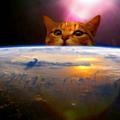
🌌🐈Gattini&Universo🐈🌌
Foto, video, gif su sutto ciò che riguarda i gatti e l'universo! ———— 🔌 contatto: @zerointernet
Show more208
Subscribers
No data24 hours
No data7 days
No data30 days
- Subscribers
- Post coverage
- ER - engagement ratio
Data loading in progress...
Subscriber growth rate
Data loading in progress...
Repost from Ask Me
What are the ultimate figures of moons in our solar system?
📍With just 12.4 km (7.7 miles) in diameter, Mars’ moon Deimos is one of the smallest known moons in our solar system.
📍With a diameter of 5,267 km (3,273 miles), Jupiter’s moon Ganymede is the largest moon in our solar system.
📍Saturn has the most number of moons: 82 moons orbit the ringed planet.
Subscribe- t.me/askmenow
Repost from Ask Me
How many moons have been discovered in our solar system?
In our system almost all major planets and even dwarf planets have moons.
Many are naturally born from the leftover gas and dust from the planet’s formation. Few others belonged to the Kuiper Belt and is believed to have been captured by gas giants.
Among the wide variety of celestial objects found in our solar system, we have 2️⃣1️⃣0️⃣ moons of varying sizes, shapes, and properties:
Earth 1️⃣ moon
Mars 2️⃣ moons
Jupiter 7️⃣9️⃣ moons
Saturn 8️⃣2️⃣ moons
Uranus 2️⃣7️⃣ moons
Neptune 1️⃣4️⃣ moons
Pluto 5️⃣ moons
Subscribe- t.me/askmenow
Repost from Ask Me
How does an occultation look like?
Enjoy a fascinating video that shows the occultation of Saturn by the Moon.🤩
15 years ago, in May 2007, using a ground-based telescope, an amateur astronomer Jan Koet had a chance to film the occultation of the second largest planet in the solar system by the Moon.
The author of the timelapse explains that he made alterations to accentuate the luminosity of Saturn.
The sequence is twice as fast as in reality.
Subscribe- t.me/askmenow
Repost from Ask Me
What is a moon and its main criteria?
We have already specified the main features of a star and a planet, let’s now also clarify what a moon is.
It would be incorrect to limit the definition of a 🌕 as any celestial object that revolves around a planet, because that would mean dust particles also fall under that category.
According to the International Astronomical Union (IAU), to be called a moon, a celestial body must satisfy the following 3️⃣ criteria:
✅ It must be in a heliocentric orbit (it must revolve around its planet, and together they both must revolve around the Sun).
✅ It should be roughly spherical in shape, but smaller than the planets (if its size is comparable to its host planet, then it would be a planet by itself, not a moon). Exception: captured asteroids don’t satisfy this criterion.
✅ It has to be massive enough to clear most of its orbit of debris so that it is the only dominant celestial body in its orbit.
Subscribe- t.me/askmenow
Repost from Ask Me
How many solar or lunar eclipses occur in one calendar year?
The answer very much depends on the year.
One calendar year has a minimum of 4️⃣ eclipses – 2️⃣ solar eclipses and 2️⃣ lunar eclipses.
Most years – such as 2022 – have only 4️⃣ eclipses, although there are years with 5️⃣ eclipses (2013, 2018 and 2019), or 6️⃣ eclipses (2011 and 2020).
❗️It is very rare to have 7️⃣ eclipses in one calendar year. The last time it happened was in 1982 and the next time will be 2038.
Any calendar year presenting the maximum of 7️⃣ eclipses must have the first eclipse coming in early January, in order to leave enough room for the seventh eclipse to take place in late December. Then the middle part of the year has to stage three eclipses within a single lunar month – the period of time between successive new moons or full moons with a mean duration of 29.53059 days.
Subscribe- t.me/askmenow
Repost from Ask Me
What are the eclipses and occultations?
✔️An occultation is a complete obscuration of the light of an astronomical body, most commonly a star, by another astronomical body, such as a planet or a satellite, without any interaction between the bodies involved. This is purely apparent and related to the observer. Hence, a total solar eclipse is the occultation of the Sun☀️ by the Moon🌕.
✔️An eclipse is the result of the total or partial masking of a celestial body by another along observers’ line of sight and regardless of their position.
Solar eclipses result from the 🌕 blocking the ☀️ relative to the 🌏; thus 🌏, 🌕 and ☀️ all lie in one line.
Lunar eclipses work the same way in a different order: 🌕, 🌏 and ☀️ all in one line, the Earth’s shadow hiding the Moon from view.
This phenomenon is visible to any observer of the Moon, regardless of its position on the surface of the Earth or in space.
Subscribe- t.me/askmenow
Show all...
CHPDB LIVE! - Annuncio nuova scoperta di Hubble
Dopo 32 anni di attività nello spazio, il telescopio spaziale Hubble riserva ancora grosse sorprese: alle 17 la NASA annuncerà una nuova scoperta fatta con d...
